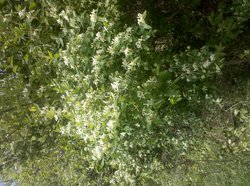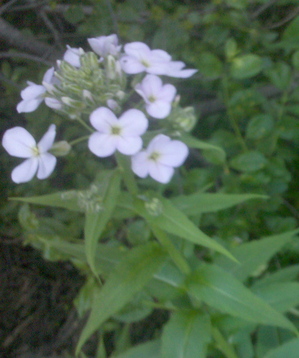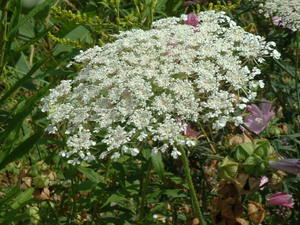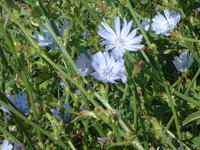Wildcrafting: Flowers that are beautiful and edible, too

Honeysuckle flower has just appeared. A great snack on a walk, or take home a few blossoms for your salad.
Linda Diane Feldt | Contributor
Flowers are romantic, exotic, and a feast for the eyes. They also can be part of your feast for consumption.
Not all flowers are edible. The most likely to be toxic are houseplants and the plants you’ve planted in your flower garden. Be especially careful close to home, and don’t eat it if you don’t know if it is safe. One example is the common daisy flower, Bellis Perennis. It is reported to have a numbing effect when chewed. I haven’t personally tried it, but this would not be a flower to surprise your dinner guests with.
The only time I ever had a negative reaction to tasting and testing plants was with a nasturtium flower. My tongue swelled up to an alarming degree. Since I’ve eaten plenty of nasturtium flowers before and since, my best guess is that some bug crawled into the flowers and that’s what caused the reaction. Nasturtiums add a great spicy surprise when added to salads or other foods. And their bright colors of orange and yellow are enticing.

Dame's Rocket is an invasive plant, with tasty flowers.
Linda Diane Feldt | Contributor
Right now Dame’s Rocket, Hesperis matronalis, is just starting to flower. This is an invasive plant that you should help remove, but in the meantime enjoy the flowers. Often mistaken for phlox, it has four petals that are white or purple or a combination. They are mild, sweet and can be used liberally in salads.
Day lily Hemerocallis is a well-known edible plant. Euell Gibbons describes making fritters of the flowers, which is a lot of work and in the end you will mostly taste the fried fat, not the flower. I rip up the leaves for a salad. The roots also are used, but go easy as too many can have cause diarrhea.
Violets Viola of course are a great addition and well-known, but have you ever tried bladder campion Silene vulgaris? The flower is unusual because of its bladder (eat that as well) and I love the taste. I learned the hard way to check the bladder first or the tiny bugs that crawl into it though. All of the garlic mustard flowers taste great, and indeed all mustard family flowers are safe to eat - although they can be too spicy for some people.
Honeysuckle Lonicera has just started to bloom, and that is also a nice bit of sweet. While I wouldn’t eat commercial rose petals, the smaller wild rose flowers are wonderful.

Wild carrot flower has little taste, but contributes its lacy beauty to cakes and salads.
Linda Diane Feldt | Contributor
The mint family flowers also are considered safe. Catnip, spearmint and chocolate mint are all a special treat. Lavender flowers also are used, but again a little goes a long way. Most of the herbs we grow - thyme, borage, comfrey, basil, oregano, and so many more all have edible flowers. And of course I recently wrote about dandelion Taraxacum flowers and shredding them into a salad for color and a slight bitter accent. Also the red bud, and poor man's pepper.
Some of my other favorites are jewel weed, chicory (you can do a maize and blue salad by combining chicory with dandelion flowers), mallow, wild carrot Daucus carota, and bee balm. They all bring different mild tastes to the table.
One way I’ve seen edible flowers used is in an ice ring. A friend froze a couple rings of ice, half filled. After they were solid she added a range of edible flowers, used edible flowers on top of the frozen ice, then added the rest of the water and put it back to freeze. Floating in a punch bowl, they were a lovely sight.

The chicory flower, combined with dandelion, could add a maize and blue theme to your next salad.
Linda Diane Feldt | Contributor
There are hundreds of edible flowers growing nearby. Start with a few you can easily identify, and learn more as the summer progresses. Confirm that they are edible before you use them.
And one more caution, an edible flower does not mean that the fruit will be safe to eat. Honeysuckle is a good example of that. Most species of honeysuckle produce toxic berries.
Your next salad could be a riot of color and tastes, just with the simple addition of a few edible flowers. And if it looks lovely, you are more likely to enjoy it.
Linda Diane Feldt is a Holistic Health Practitioner, writer and teacher with more than 30 years in private practice. You can follow her on twitter, e-mail her ldfeldt(at)holisticwisdom.org or visit her web site. A compilation of all of her AnnArbor.com blogs is almost complete on that site. Upcoming classes include guided weed walks May 23 and June 6 with a free option available through The Huron River Watershed Council on June 12. The next free class on herbs is May 27, sponsored by The People’s Food Co-op. The topic will be local medicinal herbs.


Comments
Foodie01
Sun, May 9, 2010 : 10:06 a.m.
what about sweet woodruff? I've heard it can be made into wine, but can the flowers be eaten as well?
Britta
Sun, May 9, 2010 : 7:02 a.m.
Honeysuckle(Lonicera periclymenum)or what we call: Wild honeysuckle or Autumn honeysuckle,carries "twilight flowers"; flowers sending out their sweet scent at twiligth time. Since the flower has a long and narroow reed, the nectar at its bottom can only be reached by big insects with long reeds, f ex sphinx moths(twilight moths, some of which are able to hoover in front of the flowers while sucking the honey). The roots of chicory were used during World War II as a surrogate for coffee in my country.